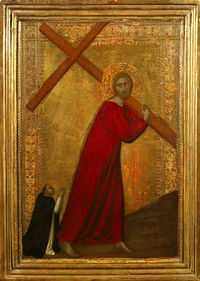Barna da Siena

Barna da Siena, also known as Berna di Siena, was a Sienese painter active from about 1330 to 1350, and was the painter in Siena during this period. He learned his trade from Simone Martini. Barna is believed to have paint the frescoes depicting the life of Jesus in the Collegiata di San Gimignano and is generally credited with Christ Bearing the Cross, with a Dominican Friar in the Frick Collection in New York City. He was killed in a fall from the scaffolding. Barna's figures are more dramatic and vigorous than any in previous Sienese painting.
Life
There is a vast amount of debate and uncertainty over who Barna da Siena was. Because of a lack of signed works Barna is credited as the master of the Collegiata di San Gimignano. It is believed that his pupil Giovanni d' Asciano assisted him on the frescoes and finished the left-over portions after Barna reportedly fell from a scaffolding and died supposedly at a young age. It is suggested, based on the works of biographer Giorgio Vasari, that the master working in the Collegiata di San Gimignano was named Bernardo Bertini. Bernardo was notably taken prisoner in 1335 during a skirmish with the Luccans. He later went to Siena and studied in Simone Martini's workshop. Documents show that in 1355 he was either absent from Siena or dead.[1] This supports the notion that Barna, the master of San Gimignano, died fairly young. Somewhere around 1360. When captured in 1335 it was noted that he was just a lad. If he was born shortly before 1320 and died somewhere before 1360 then he could not have been older than forty before his death.
Style of work
Though not much is certain about Barna's life, his work is very distinct. He is known for his dramatically expressive figures and using a more close in composition than his predecessors. His version of The Raising of Lazarus,[2] for example displays far less figures than Duccio's version and there is much more emphasis on each subjects emotions and actions. Their expressions are much more dramatic and there is a sense of human-ness that isn't seen in the work Sienese painters before him. Barna seemingly ignores the Gothic formulae exemplified by Simone Martini and his disciples.[3] Instead his figures feature a sense of volume and emotionalism, reminiscent of Lorenzetti and other Florentine painters, further strengthening the claim that Barna was not a native of Siena, but more likely hailed from Florence.
References
- Cecchi, Emilio, Sienese Painters of the Trecento, London, F. Warne, 1931.
- Ghiberti, Lorenzo, Lorenzo Ghiberti, I commentarii, Biblioteca nazionale centrale di Firenze, Firenze, Giunti, 1998.
- Vasari, Giorgio, Le Vite delle più eccellenti pittori, scultori, ed architettori, many editions and translations.
- ↑ Faison, S. L. Jr (Dec 1932). "Barna and Bartolo di Fredi". The Art Bulletin 14 (4): 285–315.
- ↑ Sullivan, Ruth Wilkins (Sep 1988). "Duccio's Raising of Lazarus Reexamined". The Art Bulletin 70 (3): 374–387.
- ↑ Pope-Hennessy, John (Feb 1946). "Barna, the Pseudo-Barna and Giovanni d'Asciano". The Burlington Magazine for Connoisseurs 88 (515): 34–37.
Further Reading
- Pope-Hennessy, John & Kanter, Laurence B. (1987). The Robert Lehman Collection I, Italian Paintings. New York, Princeton: The Metropolitan Museum of Art in association with Princeton University Press. ISBN 0870994794. (see index; plate 11-12)
External links
| Wikimedia Commons has media related to Barna da Siena. |